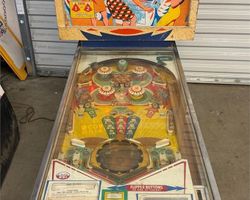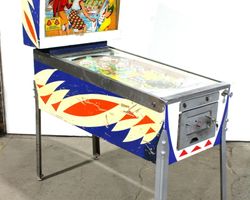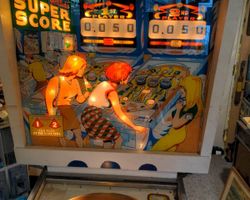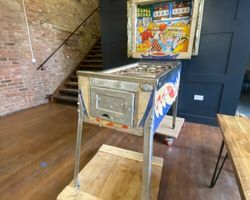Super Score
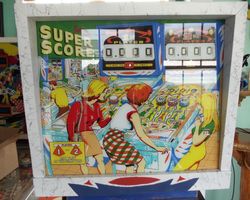
Average Prices: USD $300 to $800
Produced: April, 1967
Production Run: 2,925 units
Players: 2
Design by: Ed Krynski
Art by: Art Stenholm
The pinball machine "Super Score," released by D. Gottlieb & Co. in April 1967, represents a distinctive electro-mechanical (EM) era design. With a production run of 2,925 units, this Model 249 machine was crafted for two players, offering an experience rooted in casino and sports themes, heavily featuring roulette elements. Ed Krynski, a prolific designer for Gottlieb, spearheaded its creation, responsible not only for its design and concept but also for its animation and mechanical intricacies. The vibrant visual identity of "Super Score" was brought to life by Art Stenholm's artwork, which infused the machine with its bright, captivating aesthetic. An interesting facet of its release is that Gottlieb simultaneously offered a four-player version, "Hi-Score," in the same year, demonstrating their strategy to cater to different player group sizes with a common core design.
Signature Features and Design
"Super Score" immediately differentiates itself through several signature elements that define its gameplay and visual appeal. The most prominent mechanical innovation is its unique flipper arrangement, featuring a pair of flippers on each side of the lower playfield, controlled by a single button press per side. This dual flipper setup challenges conventional pinball control, creating a distinct feel where players can activate both flippers on a side simultaneously, an approach some find simplifies certain shots while others perceive it as reducing precision.
Central to the machine's theme and gameplay is the integrated roulette wheel. This prominent feature is not merely decorative; it serves as a primary scoring mechanism, introducing a significant element of chance into the game. The wheel's spin is accompanied by an anticipation that makes its random payouts exciting, with the potential for substantial point awards.
Art Stenholm's contribution is evident in the machine's overall aesthetic. The playfield and backglass art are consistently praised for being vibrant, colorful, and engaging, perfectly encapsulating the casino and sports theme. The artwork extends to the backglass, which features subtle nods to other Gottlieb creations, adding an extra layer of charm for enthusiasts. A particularly neat interactive feature is the backglass lighting, which illuminates to correspond with collected letters during gameplay, creating a dynamic visual feedback loop often described as an "infinity backglass" effect due to its layered appearance. The auditory experience is augmented by two bells and a knocker, providing satisfying feedback for scores and special events, particularly the thrilling sound of multiple bell strikes accompanying high point payouts.
Playfield and Mechanics
The "Super Score" playfield layout, while adhering to the EM standards of the time, offers a fast-paced and action-oriented experience. Dominating the lower half are the four flippers, arranged as two pairs, which dictate a unique rhythm of play. The compact nature of the playfield, influenced by this flipper design, contributes to a quicker game flow, keeping the ball in motion with a heightened sense of urgency.
In the upper section of the playfield, four pop bumpers are strategically placed to generate considerable ball movement and score accumulation, offering consistent action as the ball caroms off them. A passive bumper also contributes to ball deflection, guiding it into different areas. Four standup targets are distributed across the playfield, serving as key objectives for players to hit in order to activate features or accumulate points.
The machine includes two kick-out holes that can capture the ball and eject it back into play, often triggering specific scoring opportunities. A rollunder gate provides an additional pathway for the ball to traverse, contributing to the overall flow. A captive ball spinner is also present; some players note that associated gobble holes can keep this spinner constantly active, which can be either a source of ongoing points or a slight distraction depending on player preference. Art Stenholm's colorful artwork is meticulously integrated across the playfield, adorning the lanes, targets, and general surface, reinforcing the vibrant casino and sports theme and contributing to player immersion. The playfield lighting works in conjunction with the artwork, highlighting key features and guiding the player's attention through the dynamic layout.
Gameplay Dynamics
The gameplay dynamics of "Super Score" are a blend of direct target hitting and the unpredictable thrill of chance. The primary objective involves accumulating points, with a maximum displayed score of 9,999 per player. Players progress by hitting various targets and rolling over specific lanes, which contribute to their score and often light up letters on the backglass. A distinctive element of "Super Score" is how collected letters carry over between players in a two-player game, fostering a competitive environment where players can strategically build or "steal" jackpots from their opponent.
The roulette wheel mechanism is central to the scoring system. Once activated, the wheel spins, and a random point value is awarded, which can range from modest sums to massive payouts, with some spins yielding 2000 points or more, often punctuated by the distinctive sound of the 100-point bell striking repeatedly. This high-variance scoring through the roulette wheel injects an addictive element of anticipation into every game.
Beyond the luck-based payouts, players can aim for specific standup targets and activate kick-out holes to maximize their score. The unique dual flipper arrangement fundamentally shapes gameplay strategies. While some players find this setup to be a "breeze" that helps prevent flubs and acts as an "equalizer" in competitive play, others find it "trippy" and challenging to control precisely, impacting skill-shot execution. This design choice contributes to a fast and furious gameplay pace, especially given the machine's somewhat condensed playfield. The bonus scoring system, where bonus amounts do not reset after a game, introduces another layer of strategic depth for competitive play, as players can leverage this carry-over for substantial point advantage.
Reception and Legacy
"Super Score" holds a unique position in the pinball community, garnering a mixed but generally positive reception. Its strengths are frequently cited as its excellent build quality for an electro-mechanical machine from its era, its undeniably captivating artwork by Art Stenholm, and its innovative features. Enthusiasts often praise the "lovely," "super cool," and "bright and colorful" artwork, particularly appreciating the interactive backglass that lights up with collected letters, creating a visually appealing experience. The bells, especially the distinctive sound of multiple 100-point strikes for large payouts, are also well-regarded for their clarity and impact.
However, the machine's defining characteristics are also points of contention. The dual flipper layout, while seen by some as a "great equalizer" that makes games more competitive and accessible, is described by others as "frustrating" and "lacking control," making precise shots difficult and contributing to a feeling of a "short" playfield. Similarly, the central roulette wheel, while providing "addictive" anticipation and the thrill of high payouts, is often criticized for its high reliance on luck. This substantial element of chance often leads to the assessment that "Super Score" is not a "tournament game," as skill can be overshadowed by random outcomes. Minor critiques include the identical tone of the 1-point and 10-point bells, and some players find the gobble holes that keep the captive spinner constantly active more annoying than fun. The bonus amounts not resetting after a game also draws mixed opinions, seen as either a strategic competitive element or a design quirk.
Despite these divisions, "Super Score" is frequently recommended as a fun, distinctive, and visually appealing machine, especially for casual play or competitive two-player sessions where the carrying over of letters adds a unique dynamic. Its legacy lies in its willingness to experiment with fundamental pinball mechanics, particularly the flipper arrangement and the integration of a prominent luck-based feature like the roulette wheel. It stands as a testament to Gottlieb's design philosophy of the late 1960s, showcasing how they explored variations in gameplay to offer different experiences to players. While not celebrated as a pure skill machine, its unique design choices and captivating aesthetics ensure its continued relevance as an interesting and enjoyable example of electro-mechanical pinball ingenuity.
Sponsored Links
 Ebay Listings
Ebay Listings
 Auction Results
Auction Results
| Cost | Location | Date |
|---|---|---|
| USD $400 |  North Carolina, United States North Carolina, United States |
15 June, 2025 |
| USD $1,500 |  Michigan, United States Michigan, United States |
11 February, 2025 |
| USD $500 |  Pennsylvania, United States Pennsylvania, United States |
05 November, 2024 |
| USD $655 |  Virginia, United States Virginia, United States |
27 June, 2024 |
| USD $500 |  New York, United States New York, United States |
07 November, 2023 |
| USD $1,350 |  California, United States California, United States |
17 January, 2022 |
| USD $711 |  California, United States California, United States |
12 June, 2021 |
| GBP £450 |  United Kingdom United Kingdom |
05 April, 2021 |
| USD $500 |  Maryland, United States Maryland, United States |
25 March, 2021 |
| USD $900 |  Ohio, United States Ohio, United States |
17 February, 2018 |


Private Policy · Search Website · Contact Us
As an eBay Partner, we may earn a commission from qualifying purchases made through links on this site, at no additional cost to you.
All trademarks and copyrighted materials remain property of their respective owners. All other content copyright 2007 - 2025 Pinpedia.

